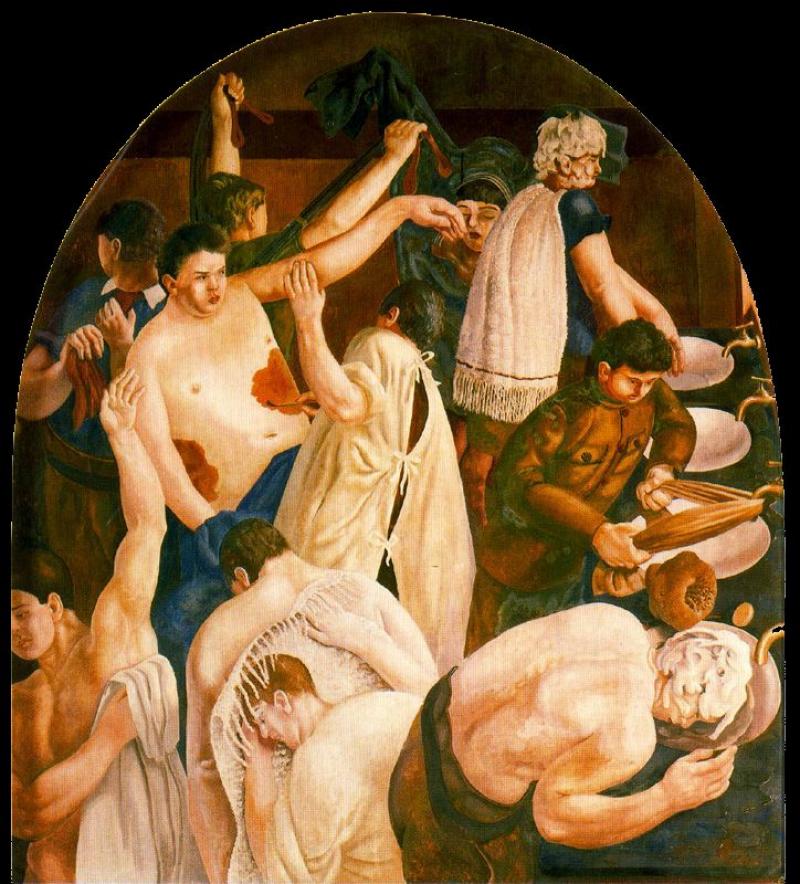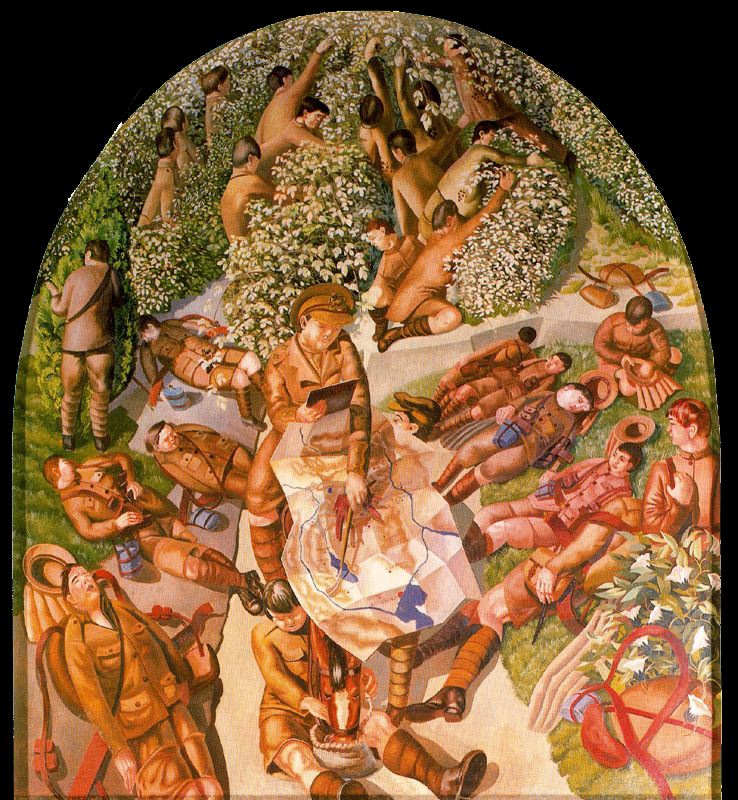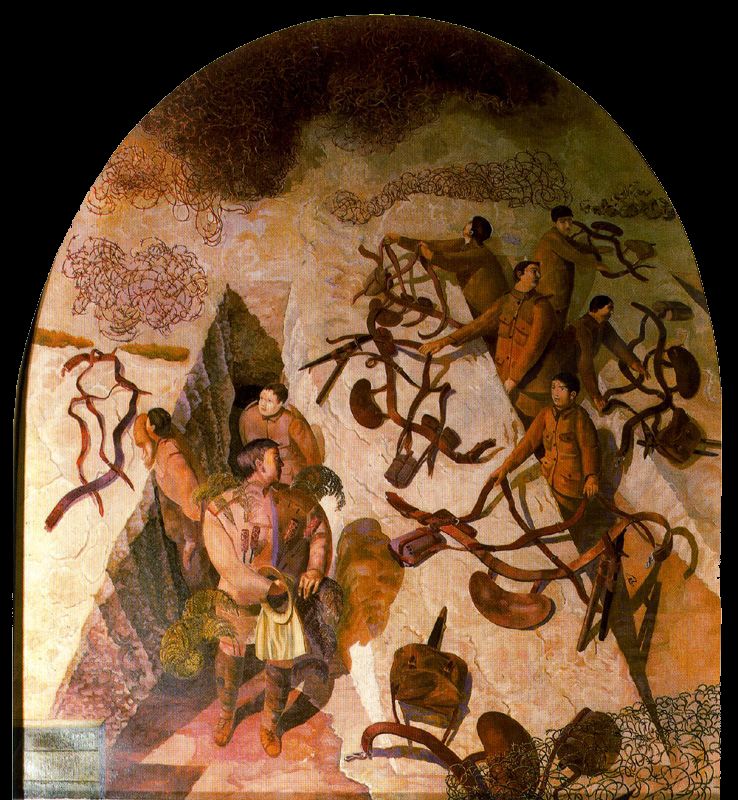Stanley Spencer: Heaven in a Hell of War, Somerset House | reviews, news & interviews
Stanley Spencer: Heaven in a Hell of War, Somerset House
Stanley Spencer: Heaven in a Hell of War, Somerset House
Away from the dimly lit chapel for which they were painted, we can see Spencer's war paintings in painstaking detail

Stanley Spencer’s painting Map Reading shows us, in dizzying perspectives and changes of scale, a mounted cavalry officer reading a huge unfurled map concerning the now forgotten campaign in Macedonia in World War I, his horse nibbling oats all the while. Clustered all around his giant figure, ordinary soldiers surround their commander, fanned out at oblique angles to his central figure.
Somerset House provides an unrepeatable experience, as we are able to see the newly restored paintings close up in bright light
Map Reading (pictured below) is but one of the commemorative 16 paintings – lunettes and predellas – which are visiting London while their normal home, the modest (but listed Grade I) red brick 1920s Sandham Memorial Chapel in Burghclere, Hampshire, now in the care of the National Trust, is conserved and restored. Three wall murals including the Resurrection, here in a major back-lit reproduction, could not be moved for this unprecedented visit to London, an exhibition Stanley Spencer (1891-1959) had passionately wished for. He knew their quality, because of his own extraordinary view of life which combined confidence and diffidence, naiveté and sophistication.
 The paintings were inspired by Spencer’s own war experience, and were six years in the making (1926-1932). They were modelled in some ways on Giotto’s early 14th-century Arena Chapel in Padua in terms of their three-tier stacking. They have Spencer’s highly unusual combination of the spiritual and the earthly, the imaginative and the real, and the quotidian and the miraculous; in that sense they also very subtly echo the ethos of Giotto’s extraordinary introduction of the realistic and the believable into the miraculous.
The paintings were inspired by Spencer’s own war experience, and were six years in the making (1926-1932). They were modelled in some ways on Giotto’s early 14th-century Arena Chapel in Padua in terms of their three-tier stacking. They have Spencer’s highly unusual combination of the spiritual and the earthly, the imaginative and the real, and the quotidian and the miraculous; in that sense they also very subtly echo the ethos of Giotto’s extraordinary introduction of the realistic and the believable into the miraculous.
The scenes are partly set in Macedonia, the campaign in which Spencer took part, and in the Beaufort War Hospital, Bristol, where he also served. In Ablutions (main picture) there is almost a sense of the wounded saint, as the sturdy half-naked solider has iodine painted on his chest wounds, while elsewhere muscled men wash themselves aided by male and female nurses in the communal hospital bathroom.
Convoy Arriving with the Wounded is just that, an open lorry carrying the helmeted soldiers, each of whom has an arm in a shining white sling, the lorry improbably surrounded by rhododendron blossom; two enormous men, one with a cluster of keys at his waist, open high iron gates to let the lorry through into the hospital. Other hospital scenes show orderlies sorting out fat padlocked black kit-bags in grim prison-like surroundings – the hospital treated both the war-wounded and the shell-shocked. Scrubbing the Floor has as its focus a shell-shoked solder prostrate in a corridor, obviously ritualistically washing the same area of dirty floor. Above this abject figure a trio of bustling workers, oblivious to his plight, carry trays of bread for the patients.
 Dug Out (pictured above) is set at the front in Salonika with soldiers standing in two trenches with their equipment laid out in front of them, their sergeant, his own uniform partly camouflaged, looking toward them; barbed wire is at the front of the image. The mood is both tense and curiously serene: Spencer wrote that he had thought how marvellous it would be if one morning we came out of our dug-outs, and somehow everything was at peace and war had ended. Reveille is also a concatenation of contradictory moods. Soldiers are leaning into a vast tent, announcing that the war is over; at the apex of the tent there are clusters of scores of insects, menacing yet passive. The tent is filled with three standing figures wrapped in elaborate mosquito nets, like transparent graves, seemingly about to burst free from their entanglement. In Spencer’s iconography, these awakened but still entrapped figures may not only soon be free, but even redeemed.
Dug Out (pictured above) is set at the front in Salonika with soldiers standing in two trenches with their equipment laid out in front of them, their sergeant, his own uniform partly camouflaged, looking toward them; barbed wire is at the front of the image. The mood is both tense and curiously serene: Spencer wrote that he had thought how marvellous it would be if one morning we came out of our dug-outs, and somehow everything was at peace and war had ended. Reveille is also a concatenation of contradictory moods. Soldiers are leaning into a vast tent, announcing that the war is over; at the apex of the tent there are clusters of scores of insects, menacing yet passive. The tent is filled with three standing figures wrapped in elaborate mosquito nets, like transparent graves, seemingly about to burst free from their entanglement. In Spencer’s iconography, these awakened but still entrapped figures may not only soon be free, but even redeemed.
The exhibition, in three galleries, is of course not the same as when visiting the chapel, where the viewer is literally and metaphorically absorbed in these teeming scenes of hope and despair, suffering and redemption.
However, the chapel is necessarily dimly lit, its details hard to see. Somerset House provides an unrepeatable experience, as we are able to see the newly restored paintings close up in bright light, appreciate the dizzying changes of scale, and the detail, often almost exquisite, of tent and military uniform and kit, the sand and arid landscape of Macedonia, the prison-like aspect of the Bristol hospital, the explosions of foliage and blossom. All is in a restricted range of colours – ochres, reds, rusts, browns, whites, occasional deep blues – which nevertheless convey bursts of light. Facial expressions are almost uniformly wooden, any liveliness apparent in body language. Spencer, through his own intensely idiosyncratic, eccentric, inimitable idiom, somehow conveys a range of expressions from acceptance, through resignation, to hope. He continually plays with the passive – the sleeping men – and the active, the hospital orderlies, the soldiers anticipating action.
Above all, in his elaborate, crowded, convincing compositions, Spencer is attentive to conveying through a myriad of details, the men at the heart of war – and peace.
Explore topics
Share this article
The future of Arts Journalism
You can stop theartsdesk.com closing!
We urgently need financing to survive. Our fundraising drive has thus far raised £49,000 but we need to reach £100,000 or we will be forced to close. Please contribute here: https://gofund.me/c3f6033d
And if you can forward this information to anyone who might assist, we’d be grateful.

Subscribe to theartsdesk.com
Thank you for continuing to read our work on theartsdesk.com. For unlimited access to every article in its entirety, including our archive of more than 15,000 pieces, we're asking for £5 per month or £40 per year. We feel it's a very good deal, and hope you do too.
To take a subscription now simply click here.
And if you're looking for that extra gift for a friend or family member, why not treat them to a theartsdesk.com gift subscription?
more Visual arts
 'We are bowled over!' Thank you for your messages of love and support
Much-appreciated words of commendation from readers and the cultural community
'We are bowled over!' Thank you for your messages of love and support
Much-appreciated words of commendation from readers and the cultural community
![SEX MONEY RACE RELIGION [2016] by Gilbert and George. Installation shot of Gilbert & George 21ST CENTURY PICTURES Hayward Gallery](https://theartsdesk.com/sites/default/files/styles/thumbnail/public/mastimages/Gilbert%20%26%20George_%2021ST%20CENTURY%20PICTURES.%20SEX%20MONEY%20RACE%20RELIGION%20%5B2016%5D.%20Photo_%20Mark%20Blower.%20Courtesy%20of%20the%20Gilbert%20%26%20George%20and%20the%20Hayward%20Gallery._0.jpg?itok=7tVsLyR-) Gilbert & George, 21st Century Pictures, Hayward Gallery review - brash, bright and not so beautiful
The couple's coloured photomontages shout louder than ever, causing sensory overload
Gilbert & George, 21st Century Pictures, Hayward Gallery review - brash, bright and not so beautiful
The couple's coloured photomontages shout louder than ever, causing sensory overload
 Lee Miller, Tate Britain review - an extraordinary career that remains an enigma
Fashion photographer, artist or war reporter; will the real Lee Miller please step forward?
Lee Miller, Tate Britain review - an extraordinary career that remains an enigma
Fashion photographer, artist or war reporter; will the real Lee Miller please step forward?
 Kerry James Marshall: The Histories, Royal Academy review - a triumphant celebration of blackness
Room after room of glorious paintings
Kerry James Marshall: The Histories, Royal Academy review - a triumphant celebration of blackness
Room after room of glorious paintings
 Folkestone Triennial 2025 - landscape, seascape, art lovers' escape
Locally rooted festival brings home many but not all global concerns
Folkestone Triennial 2025 - landscape, seascape, art lovers' escape
Locally rooted festival brings home many but not all global concerns
 Sir Brian Clarke (1953-2025) - a personal tribute
Remembering an artist with a gift for the transcendent
Sir Brian Clarke (1953-2025) - a personal tribute
Remembering an artist with a gift for the transcendent
 Emily Kam Kngwarray, Tate Modern review - glimpses of another world
Pictures that are an affirmation of belonging
Emily Kam Kngwarray, Tate Modern review - glimpses of another world
Pictures that are an affirmation of belonging
 Kiefer / Van Gogh, Royal Academy review - a pairing of opposites
Small scale intensity meets large scale melodrama
Kiefer / Van Gogh, Royal Academy review - a pairing of opposites
Small scale intensity meets large scale melodrama
 Jenny Saville: The Anatomy of Painting, National Portrait Gallery review - a protégé losing her way
A brilliant painter in search of a worthwhile subject
Jenny Saville: The Anatomy of Painting, National Portrait Gallery review - a protégé losing her way
A brilliant painter in search of a worthwhile subject
 Abstract Erotic, Courtauld Gallery review - sculpture that is sensuous, funny and subversive
Testing the boundaries of good taste, and winning
Abstract Erotic, Courtauld Gallery review - sculpture that is sensuous, funny and subversive
Testing the boundaries of good taste, and winning
 Edward Burra, Tate Britain review - watercolour made mainstream
Social satire with a nasty bite
Edward Burra, Tate Britain review - watercolour made mainstream
Social satire with a nasty bite
 Ithell Colquhoun, Tate Britain review - revelations of a weird and wonderful world
Emanations from the unconscious
Ithell Colquhoun, Tate Britain review - revelations of a weird and wonderful world
Emanations from the unconscious

Add comment